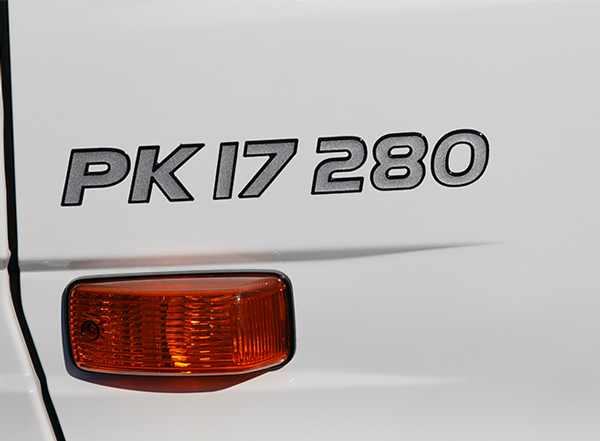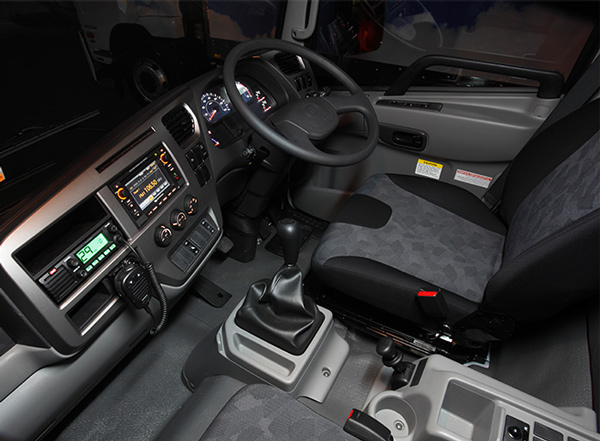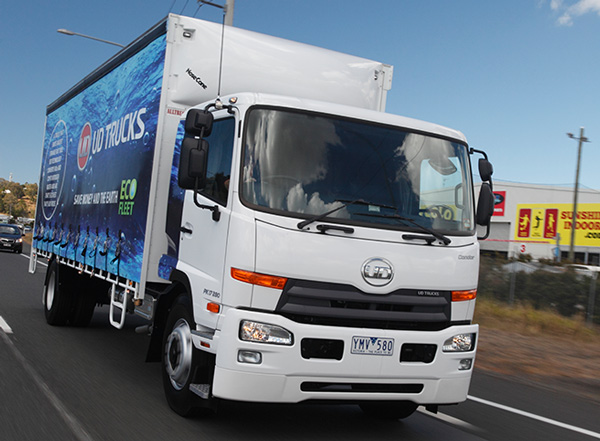UD Trucks relaunched its brand at around the same time as ADR 80/03 emission regulations. Gary Worrall discovered what was new on a UD Trucks PK 17 280.
The new UD Trucks PK 17 280 adopts the Japanese naming structure, so that the ‘family’ name is Condor, common between all MK and PK variants, followed by the MK or PK identifier, the gross mass and finally the horsepower rating, so that the test truck is the Condor PK 17 280, a 17-tonne gross vehicle mass (GVM) with 280hp (208kW).
The new model uses the UD-developed GH7 engine, a 7-litre displacement six cylinder engine using common-rail fuel injection producing up to 883 Nm of torque.
More impressive for operators is the opportunity to push service intervals out to 30,000km by using UD’s own specification oil, while fleet users are reporting AdBlue consumption of approximately 4 percent, or more than 5,000km per tank.
Virtually the only unchanged element about the PK is that it remains a cabover model. Almost everything else on the truck is new.
The front end looks more rounded, with the previous square sides now smoothed off for a less aggressive greeting, with high-mounted indicators at the upper edges of the grille.
The front end looks taller than its predecessor, while the multi-reflector halogen headlights now sit inside the front bumper, which is now an aerodynamic cover for the standard-fit front under run protection system (FUPS) bar.
The top cover opens out to allow access to all major engine inspection points, allowing the driver to complete a daily check quickly and accurately, without raising the cab.
The door-mounted mirrors are larger than previously, however the thin A-pillar means there is still a gap between the mirror frames and the door to help reduce the blind spot generated by the Euro-style housing.
The upshot of this fitting is that the mirrors are not prone to blurring from engine vibrations.
The cab steps are broad, with plenty of space for even club-footed journalists, while a handy little design feature is the flexible mount and rubber anti-splash flap that keeps the step from getting covered in road grime.
Even the windscreen wipers are new, with the current model only using two centre-pivoting wipers in place of the previous version’s three wipers.
While this might seem trivial, in reality it reduces the number of replacement blades operators must carry, in turn contributing to a lower cost of service.
Japanese trucks have always been well-built and the new PK is no exception. Panel gaps are uniform and narrow, while the paint and other external trim is first rate.
Engine
The GH7TB engine is all-new and was designed completely in-house by UD Trucks to meet Euro 5 emission standards. It uses selective catalytic reduction (SCR) to eliminate noxious gases from the exhaust.
Best of all for operators, UD says service intervals can be pushed out to 30,000km, depending on the application, while standard testing of fuel consumption reveals close to 10 per cent lower fuel burn than previously.
The GH7 engine is a creamy smooth unit. At idle, it is a quiet murmur under the cab somewhere, with a barely perceptible vibration inside the cab. The torque effect of the engine is efficiently damped by the cab suspension.
The new engine is civilised, even when approaching redline it retains its smooth exhaust note, while the torque curve extends down to 1,000rpm allowing the driver to hold gears on hill climbs.
Transmission
The gear shift is light. The 6-speed unit is synchro on the top five ratios, but remains straight cut on first for greater durability in high load crawling operations.
For drivers with a more precise sense of feel, the transmission is a delight, although I must ‘fess up to being a little ham-fisted occasionally and pushing through the spring-loaded lock out on reverse, thus finding myself reversing away from the traffic lights more than once.
After a quick refresher course on the merits of ‘soft hands’ when driving, the transmission proved to be a delight, initial ‘notchiness’ disappears when the engine is taken up past 2,100rpm; the gears literally fall to hand with hardly any effort from the operator.
Cab and Controls
While the cab has been redesigned, certain elements were retained as fundamental, including the need for doors that open a full 90 degrees for ease of entry and exit, as well as side intrusion bars to complement the ECER29 crashworthiness certification.
The cab redesign translates into more room for the driver. Taller drivers in particular will enjoy the increased head and leg room, with the driver’s knee now well clear of the dash panel.
The dash is easy to read, with big dials for the speedo and tacho, flanked by smaller gauges for the brake pressures, temperatures and fuel levels.
There is also an LCD screen for a number of engine warning messages. Despite being told about them, none flashed up on the screen during any of our test drives.
The cab layout remains simple. Despite the extra equipment, the packaging is focused on the driver’s needs, with buttons and dials all easy to reach; even the CB radio is mounted so the driver can comfortably pick up the microphone.
The park brake is well-placed by the driver’s left thigh so hill starts are simple affairs; as the driveline engages the clutch can be released for a smooth take-off.
The only real complaint is the peripheral buttons on the entertainment centre — ‘radio’ no longer does them justice — are small, and it is possible to select the wrong function when not looking at the unit.
The integrated satellite navigation can be used as a mobile street directory; it comes standard with navteq mapping, as well as offering turn-by-turn navigation, and includes a vocal reminder of speed limits based on the vehicle’s reported position.
Generally accurate, the navigator was occasionally caught out by the ongoing road works on the Great Western Highway out towards Lithgow, west of Sydney, but the prompts were welcome when traversing school zones as a reminder to get the speed under the 40km/h limit.
Importantly for professional drivers, the entertainment centre includes standard Bluetooth connectivity, top marks to UD for fitting it, truck drivers are as susceptible to traffic infringements as everyone else.
Also handy was the rear-mounted camera. While it automatically switches on when reverse is engaged, the unit can manage three cameras, all with external microphones, making it possible for the truck to be guided into tight spaces with outside help.
UD uses seats by specialist manufacturer CVG. These are air suspension units with multiple adjustments, and are very comfortable, providing plenty of support on a variety of second-rate roads around both Brisbane and Sydney.
Although plated for three people, the PK is best enjoyed two-up; the outboard passenger gets a full three-point seatbelt and a full-size seat, while the inner seat is a lap belt only.
More importantly, in two-up configuration the seat back folds down in the centre and becomes a work table with drink holders.
With personal hydration a hot topic in the current era, the PK cab also includes a coffee cup holder beside the park brake, as well as bottle holders in the doors.
Although cloth-trimmed, the seats are easy to clean, while the vinyl flooring allows mud and dirt to swept out the doors with minimum effort.
The cab offers outstanding levels of noise and heat proofing. Even the fan was barely audible when it engaged, while the panel fit ensures no extraneous dust or draughts creep inside to annoy the driver.
Performance
With our test loop starting and finishing in Chullora with a rest stop at Lithgow on the other side of Mount Victoria pass, the Condor’s exhaust brake proved its worth.
In combination with third gear, the Condor eased its way down the hills with only a couple of brake applications to maintain the preferred road speed.
A barely audible component, the exhaust brake, as on previous models, is linked to the accelerator so the driver can make fine adjustments to road speed by opening and closing the throttle, to lose 2–3km/h just release the throttle, while accumulating speed requires just a slight pressure to close the brake valve.
Service brakes are all-wheel drums, with full air actuation. The reservoir holds more than enough to deal with multiple applications and the only time the low air alarm was triggered was when the brakes were deliberately pumped to drop the pressure; it is hard to imagine a scenario where the truck could run out of air in normal driving.
The steering is possibly the Condor’s best attribute. While attempting to locate a loading bay for a reverse test, it was necessary to drive through a crowded laneway with 10cm clearance to the parked vehicles.
A challenge even in a straight line, the task was complicated by cars jutting into the roadway, requiring changes of direction to clear the route without touching any obstacles.
While the heart rate was elevated from the concentration, the task was simplified by the power steering, which removed the physical effort, and also by the accuracy of the steering, with no ‘slop’ around dead centre making precise inputs easy.
Importantly, although light, the steering retained a sense of feel, allowing the driver to predict how much lock was being applied, preventing a potentially catastrophic — and expensive — meeting with the surrounding cars.
Similarly, reversing into a number of supermarket loading docks was barely a challenge, with the accurate steering aided by the well placed ‘Euro style’ mirrors and the reversing camera — although the camera was almost made redundant, such was the field of view offered by the electrically-adjustable mirrors.
The test truck was fitted with front leaf springs and Hendricksen air suspension on the rear, and proved more than capable of absorbing the potholes that make up the roads over the Blue Mountains west of Sydney.
With some holes more like trenches dug across the road, the Condor remained under full driver control at all time, while the instinct was to lift off at the sight of some of the larger divots, the PK was not fussed at all.
The rear suspension can be electronically controlled, allowing the tailgate to be raised or lowered to meet different dock heights for ease of loading.
The overall ride was composed and surefooted, inspiring confidence in the truck regardless of the weather, with Sydney providing the odd heavy rain shower to test the wipers and grip levels.
Verdict
In previous lives the PK was a solid work truck; there were no frills or frippery, but it had a loyal following especially among local government.
Erik Andersson, Oceania Region President of UD Trucks, acknowledges that moving to a higher specification could alienate those supporters, but he also points out the potential to win new friends courtesy of the improved internal fit out.
The good news is the all-new engine has only improved the PK as an on-road performer, while also improving the driver’s quality of life.
With almost the entire truck brand new, UD is rightfully pinning its hopes on the new Condor range. It’s now in the hands of the market to make the final call.
Likes:
- Smooth engine, wide torque band
- Light clutch and gear shift operation
- Increased cab size offers more room and better vision
- General driving dynamics
Dislikes:
- Lack of three-point seatbelt for middle seat
- Filler necks on fuel and DEF tanks could be longer to clear body overhang
Specifications
Make/Model: UD Trucks PK 17 280
Configuration: 4×2 medium-rigid truck
Engine: GH7TB 7-litre inline six cylinder intercooled turbocharged diesel, four valves per cylinder, ultra high pressure common-rail direct injection
Outputs: 214kW @ 2,500rpm/917Nm @ 1,400rpm
Emission Control: Euro 5, via SCR (selective catalytic reduction)
Fuel Capacity: 200-litre steel diesel tank, 50-litre polymer AdBlue (DEF) tank
Transmission: 6-speed synchro transmission (first gear non-synchro)
GVM/GCM: 16,500kg/20,500kg
Wheelbase: Up to 6,450mm
Brakes: Air-operated drum brake front and rear, with Wabco ABS anti-lock braking, driver-controlled exhaust brake
Suspension: Long Taper Leaf spring front/2-bag Hendrickson HAS320 airbag suspension with ECAS (electronically controlled air suspension) rear




